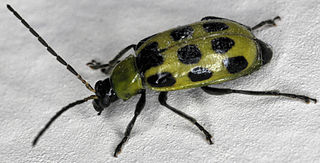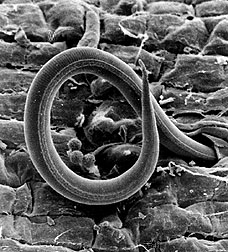Interactions
Cucumis melo interacts with a variety of organisms, be it herbivores, nematodes, members arthropoda, and bacteria Each one participates in symbiosis with Cantaloupe.
Bacteria:
Cucumis melo usually has a netted rugged skin called a rind, which is great surface for bacteria to grab on to and grow. A major bacteria that caused widespread scare was listeria from cantaloupes from Jensen farm. Other major ones are E. coli and salmonella. Another major bacteria that actually infects the cantaloupe is bacterial wilt. The bacteria that causes this is located in the stomachs of cucumber beetles. They spread the wilt by either there mouth parts or by their feces. Once inside the cantaloupe, the bacterium multiplies extremely fast in the vascular system, forming blocks that cause the leaves to wilt from lack of nutrients.
bacterial wilt, by Eeshie
Cucumber Beetle:
The beetles search for cucumber and cantaloupe plants to devour amd lay their eggs at the base of the plant. Once the eggs hatch the larvae feed on the roots. Then the larvae will go into pupate and wait till spring over the winter. They are a major pest which can ruin many Cucumis plants. Furthermore, they can spread bacterial wilt on cantaloupe that can devastate the crop.
root-knot nematodes
A Root-knot nematode, Meloidogyne incognita, is the most common species of nematode which attacks this crop. This nematode causes lesions in the rhizome epidermis which can be invaded to allow access points for bacteria and fungus to enter the rest of the plant.
Photo by William Wergin and Richard Sayre
Fungus:
One of the most prevalent fungus in plants is Powdery mildew. It produces mycelium that grow on the surface of the plant and send rootlike structures called haustoria into the top cells of the plant. The spores in spring are transferred by rain, wind or other organisms. There are some resistant strains of cantaloupe that are able to resist this fungus.

